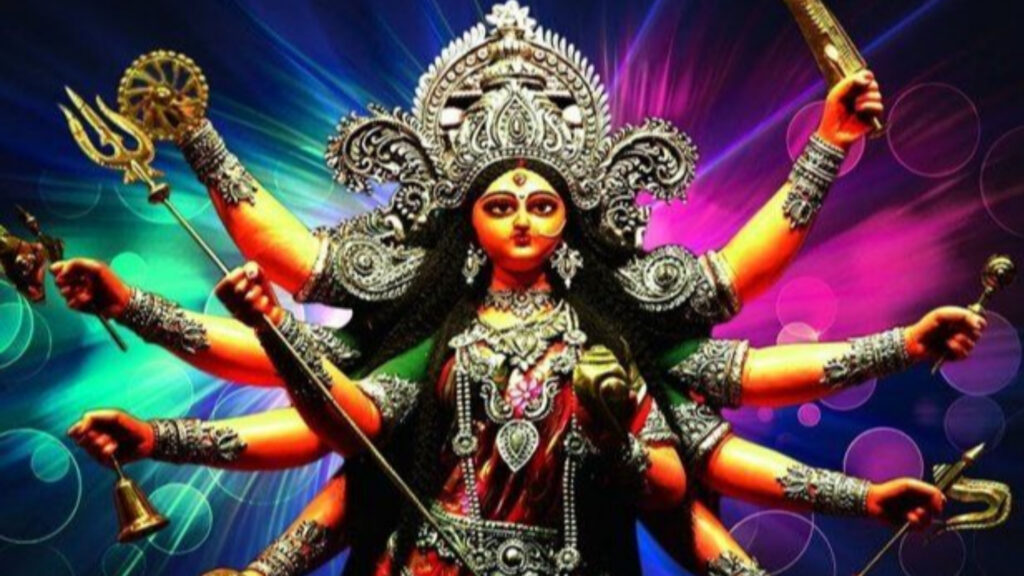
In Navaratri, the significance of the 9 goddesses is as follows:
1. Shailaputri: Shailaputri is the first form of Goddess Durga. She is known as Shailaputri because she is the daughter of the mountain king Himalaya. She is worshipped on the first day of Navaratri. She is also known as Vrisharudha because her vehicle is a bull. Shailaputri holds a trident(trishool) in her right hand and a lotus in her left hand. She is also known as Sati.

2. Brahmacharini: On the second day of Navaratri, Mother Brahmacharini is worshipped. On this day, devotees immerse their minds in the feet of the Divine Mother. “Brahma” means tapasya (austerity) and “charini” means one who practises. Thus, Brahmacharini signifies one who practises austerity. Goddess Parvati underwent severe penance to attain Lord Shiva as her husband. Due to her intense tapasya, she came to be known as Tapashcharini or Brahmacharini. It is believed that through the grace of Goddess Brahmacharini, one can attain all success. Therefore, on the second day of Durga Puja, devotees worship this aspect of the Goddess. The essence of the story of this Goddess is to remain steadfast even in the face of life’s struggles.
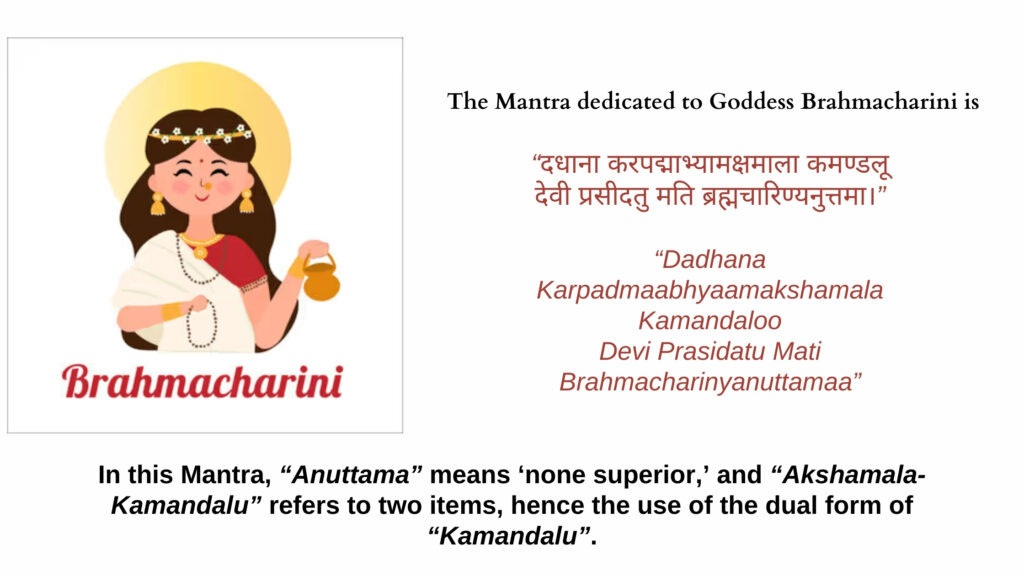
3. Chandraghanta: Chandraghanta is the third form of Mother Durga worshipped on the third day of Navaratri. She signifies peace and benevolence. Devotees meditate on their divine form, seeking supernatural experiences. She is depicted with a crescent moon on her forehead, riding a lion, and holding weapons. Worshipping Chandraghanta instils bravery, fearlessness, gentleness, and humility in devotees.
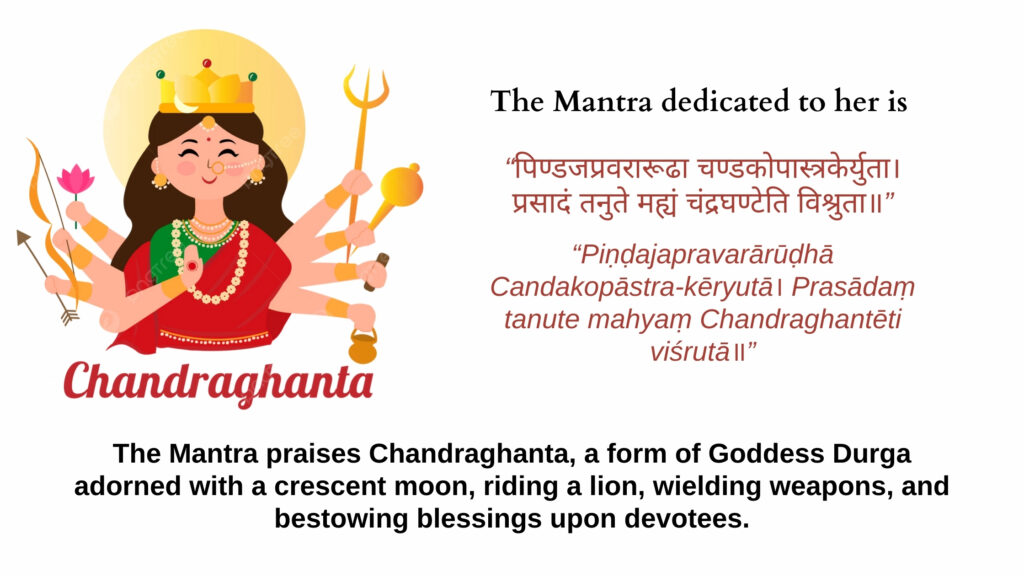
4. Kushmanda: On the fourth day of Navaratri, devotees worship Goddess Kushmanda. This deity is known for creating the universe with her divine smile, earning her the name Kushmanda. She is regarded as the primal form of creation, bringing light to the darkness that prevailed before the existence of the cosmos. Goddess Kushmanda is depicted with eight arms, each holding symbolic items like a kamandalu (water pot), Dhanush (bow), bana (arrow), lotus flower, amrit kalash (pot of nectar), chakra (discus), and gada (mace). Her eighth hand holds a japa mala (prayer beads) symbolising the bestowal of blessings and achievements. Devotees should worship Goddess Kushmanda with a pure and devout heart on the fourth day of Navaratri. Her worship brings relief from ailments and sorrows while bestowing longevity, fame, strength, and health upon the devotee. She is pleased with sincere devotion and blesses her devotees with ease in attaining the ultimate goal.
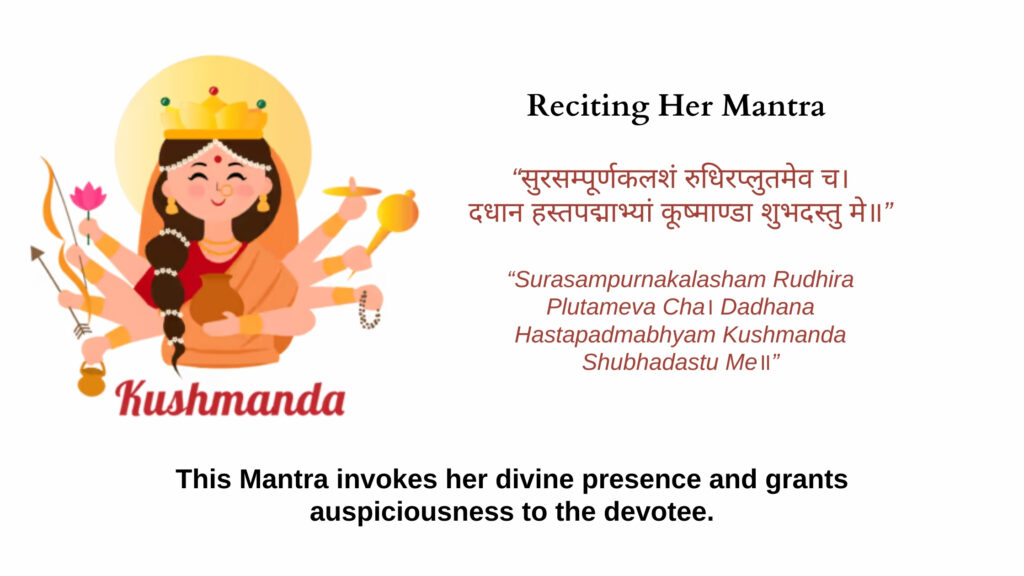
5. Skandamata: The fifth day of Navaratri is dedicated to Skandamata, the mother of Lord Kartikeya. She is depicted with four arms, holding Skanda on her lap, a lotus flower, and bestowing blessings. Skandamata’s worship signifies the creation of consciousness and grants the fulfilment of desires, leading to liberation. Riding a lion, she symbolises courage and righteousness. Her worship brings radiance and fulfilment to devotees, enabling them to overcome obstacles on the path to liberation.
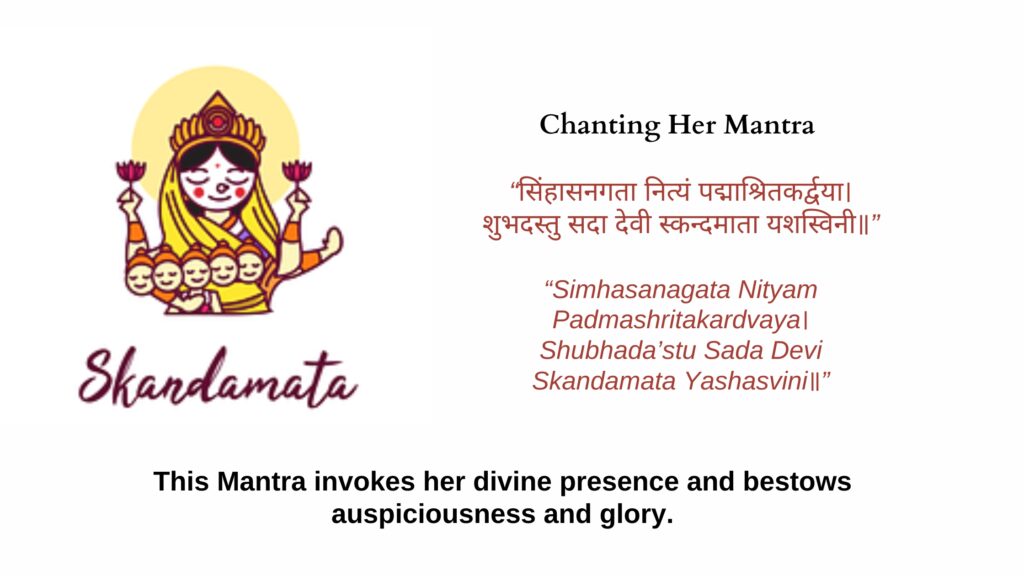
6. Katyayani: The sixth form of Goddess Durga is Katyayani, worshipped on the sixth day of Navaratri. Devotees meditate on the Ajna Chakra, significant in yoga. Legend has it that Sage Katyayan worshipped intensely to have a daughter, who incarnated as Katyayani. Her blessings fulfil desires and grant liberation from suffering and past sins. Katyayani’s divine form radiates grace, with four arms symbolising protection and blessings, riding a lion. Worshipping Katyayani brings worldly prosperity and spiritual liberation, making her revered in modern times.
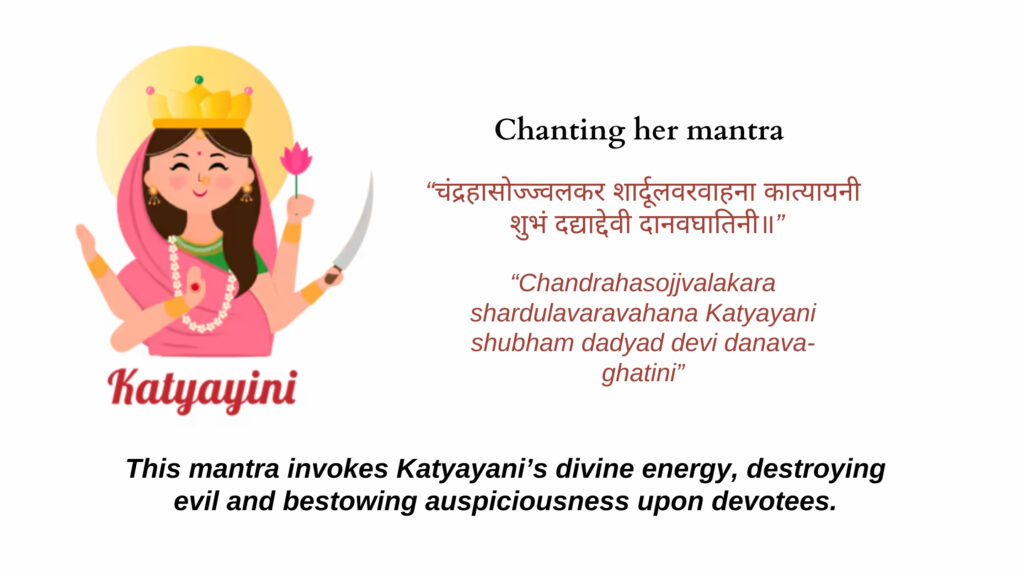
Seeking a Happier Home? Consult for Vastu Advice for Positive Vibes!
7. Kaalratri: The seventh form of Goddess Durga is known as Kaalratri. She is worshipped on the seventh day of Navaratri, and her devotees focus on the Sahasrara Chakra, associated with cosmic consciousness. Kaalratri is revered for her fierce form, symbolising the destruction of darkness and protection from evil. Her dark complexion and wild appearance evoke awe and respect. With three eyes emitting flames, Kaalratri rides a donkey, symbolising swift justice and protection. Her right-hand displays the Var Mudra, granting blessings, while the left hand shows the Abhaya Mudra, signifying fearlessness. Adorned with a sword and a deadly iron hook, Kaalratri’s appearance may be fearsome, but she bestows auspiciousness upon her devotees, protecting them from all forms of fear. Worshipping Kaalratri opens the doors to cosmic powers and drives away negative forces, ensuring the devotees’ protection and prosperity.
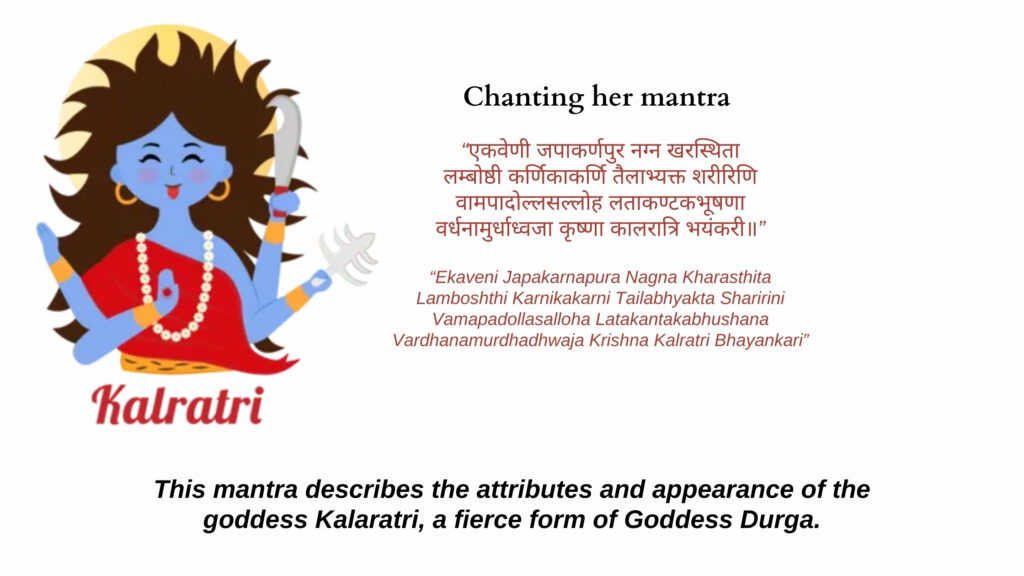
8. Mahagauri: Mahagauri, the eighth form of Goddess Durga, is worshipped on the eighth day of Navaratri. She is depicted with a fair complexion, dressed in white attire, and rides a bull. With four arms, she displays the Abhaya Mudra and carries a trident, damaru, and gestures to Var Mudra. Legend has it that she attained Lord Shiva as her consort after rigorous penance, symbolising purity and overcoming darkness. Worshipping Mahagauri is believed to cleanse devotees of impurities and sins, granting them divine blessings and marital bliss. She is also known as Annapurna and Chaitanyamayi, delighting Lord Shiva with her devotion.
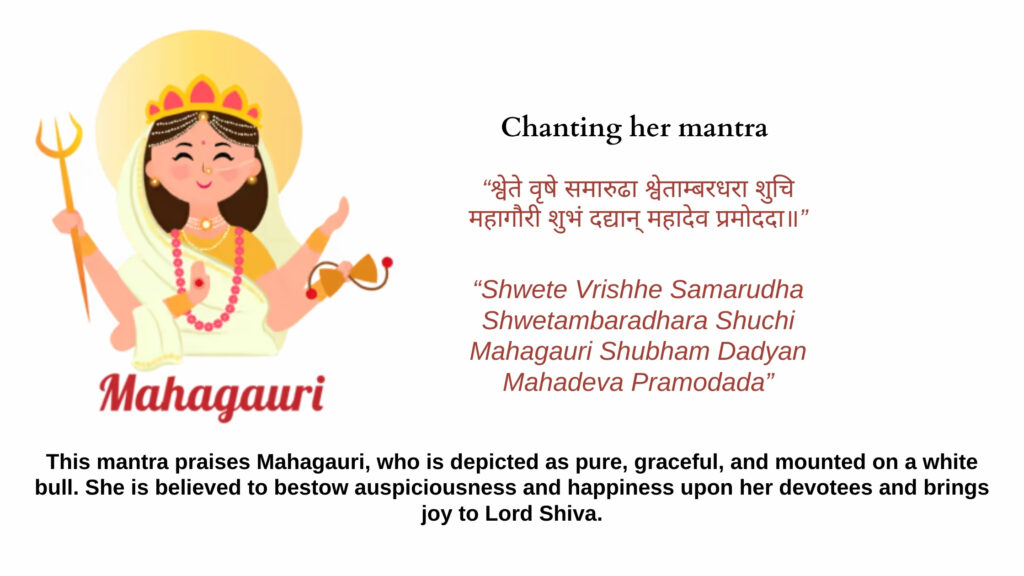
9. Siddhidatri: Maa Durga’s ninth form is Siddhidatri, the bestower of all types of accomplishments. She is worshipped on the ninth day of Navaratri. It is believed that sincere devotion and adherence to rituals on this day lead to the attainment of all achievements. Siddhidatri holds a discus in her lower right hand, a mace in the upper right, a conch in the lower left, and a lotus in the upper left hand. Her vehicle is a lion, and she sits on a lotus flower. Legend has it that Siddhidatri grants all kinds of accomplishments, making even the toughest tasks achievable with her grace. She bestows eight siddhis: Anima, Mahima, Garima, Laghima, Prapti, Prakamya, Ishita, and Vashita. It is said that Lord Shiva himself attained these siddhis through her grace, hence earning the title of Ardhanarishvara.
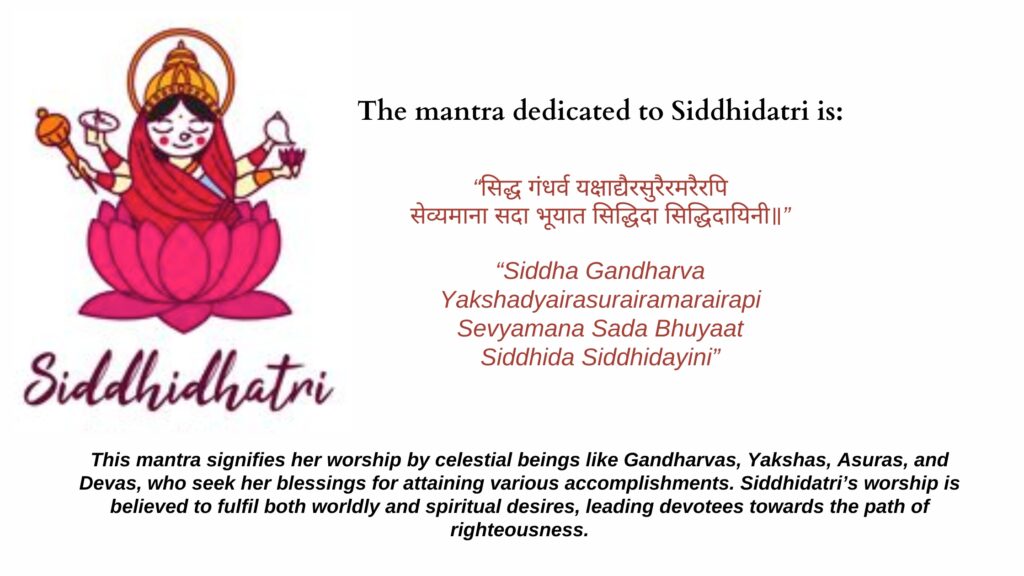
Also Read: Navratri (Significance and Tales of Navratri)
Here are the things to be avoided during fasting:
1. Leaving the Home Empty: During Navaratri, if you have set up Mata’s shrine and lit the perpetual flame, do not leave the house empty. Do not lock the house, and always ensure that someone is present at home.
2. Sattvic Diet: Consume a sattvic diet during Navaratri. Avoid meat, garlic, and onions. If you are fasting during Navaratri, also avoid grains and plain salt.
3. Children’s Hair Cutting: It is considered auspicious to have children’s haircuts during Navaratri. However, avoid cutting hair, beards, and nails during this time.
4. Wearing Black Clothes: Avoid wearing black clothes during the entire nine days of Navaratri. Also, refrain from using leather items such as shoes, slippers, bags, and belts.
5. Respecting Women: Women are considered embodiments of the Goddess. Therefore, do not disrespect any girl during Navaratri. It displeases Goddess Durga.
6. Wearing Unclean Clothes: Those fasting should avoid wearing dirty and unwashed clothes.
7. Avoid Leather Items: Fasting individuals should refrain from using leather items such as belts, shoes, bags, etc.
8. Avoid Cutting Lemons: Do not cut lemons for nine days during the fast.
9. Avoid Grains and Salt: During fasting for nine days, avoid consuming grains and salt.
10. Avoid Sleeping During Daytime: According to the Vishnu Purana, sleeping during the day is prohibited during Navaratri fasting.
11. Take a Fruit Diet at One Place: If you are fasting and consuming only fruits, take your fruit diet at one place.
Follow us on social media for cool astrology content! Get a daily horoscope, learn about the stars, and join our community! Follow us now! 🌟 on Instagram, Twitter, and Facebook
![]()

